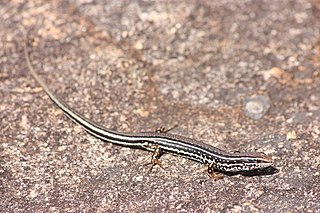The Lancelin Island skink, also known commonly as the Lancelin south-west ctenotus and the south-west ctenotus, is a species of skink, a lizard in the subfamily Sphenomorphinae of the family Scincidae. The species is endemic to Australia.
Ctenotus zebrilla, also known commonly as the Southern Cape York fine-snout ctenotus, is a species of skink, a lizard in the family Scincidae. The species is endemic to Australia.

Pseudemoia baudini, also known commonly as Baudin's skink, Baudin's window-eyed skink, and the Bight Coast skink, is a species of lizard in the family Scincidae. The species is endemic to Australia.
Ctenotus alleni, also known commonly as the Ajana ctenotus and Allen's ctenotus, is a species of skink, a lizard in the subfamily Sphenomorphinae of the family Scincidae. The species is endemic to the Australian state of Western Australia.
Ctenotus ariadnae, also known commonly as Ariadna's ctenotus, is a species of skink, a lizard in the family Scincidae. The species is endemic to Australia.

Ctenotus burbidgei, also known commonly as the plain-backed Kimberley ctenotus, is a species of skink, a lizard in the family Scincidae. The species is native to Western Australia.
Ctenotus colletti, also known commonly as the buff-tailed finesnout ctenotus, Collett's ctenotus, and Collett's skink, is a species of lizard in the family Scincidae. The species is endemic to Australia.
Ctenotus delli, also known commonly as the Darling Range south-west ctenotus or the Darling Range southwest ctenotus, is a species of skink, a lizard in the family Scincidae. The species is endemic to Australia.
Ctenotus ehmanni, also known commonly as the brown-tailed finesnout ctenotus or Ehmann's ctenotus, is a species of skink, a lizard in the family Scincidae. The species is endemic to the Australian state of Western Australia.

Ctenotus essingtonii, also known commonly as Essington's ctenotus and the lowlands plain-backed ctenotus, is a species of skink, a lizard in the family Scincidae. The species is endemic to the Northern Territory in Australia.
Ctenotus greeri, also known commonly as Greer's ctenotus and the spotted-necked ctenotus, is a species of skink, a lizard in the family Scincidae. The species is endemic to Australia.
Ctenotus hilli, also known commonly as Hill's ctenotus and the Top-end lowlands ctenotus, is a species of lizard in the subfamily Sphenomorphinae of the family Scincidae (skinks). The species is endemic to the Northern Territory in Australia.
Ctenotus joanae, also known commonly as the blacksoil ctenotus and the black-soil ctenotus, is a species of lizard in the subfamily Sphenomorphinae of the family Scincidae (skinks). The species is endemic to Australia.

Ctenotus labillardieri, also known commonly as the common south-west ctenotus, Labillardier's ctenotus, and the red-legged ctenotus, is a species of skink, a lizard in the family Scincidae. The species is endemic to the Australian state of Western Australia.

Ctenotus leae, also known commonly as the Centralian coppertail, Lea's ctenotus, and the orange-tailed finesnout skink, is a species of lizard in the subfamily Sphenomorphinae of the family Scincidae. The species is endemic to Australia.

Ctenotus leonhardii, known by the common names Leonhardi's ctenotus, Leonhardi's skink, and the common desert ctenotus, is a species of lizard in the subfamily Sphenomorphinae of the family Scincidae. The species is found in a range of arid and semi-arid regions throughout mainland Australia. Named after German anthropologist Moritz von Leonhardi in 1919, it belongs to the genus Ctenotus, one of the largest genera of lizards in Australia.
Ctenotus youngsoni, also known commonly as the Shark Bay south-west ctenotus and Youngson's ctenotus, is a species of skink, a lizard in the family Scincidae. The species is endemic to Australia. The specific name, youngsoni, is in honour of Australian zoologist William Kenneth Youngson. C. youngsoni is found in the Australian state of Western Australia. The preferred natural habitat of C. youngsoni is shrubland. C. youngsoni has well-developed limbs, with five toes on each of its four feet. C. youngsoni is oviparous.
Lerista haroldi, also known commonly as the Gnaraloo mulch-slider and Harold's lerista, is a species of skink, a lizard in the family Scincidae. The species is native to the Australian state of Western Australia.
Notoscincus butleri, also known commonly as Butler's snake-eyed skink, the lined soil-crevice skink, and the lined soil-crevis skink, is a species of lizard in the family Scincidae. The species is endemic to Australia.

Ctenotus helenae, also known commonly as the clay-soil ctenotus, is a species of skink, a lizard in the family Scincidae. The species is endemic to Australia.







